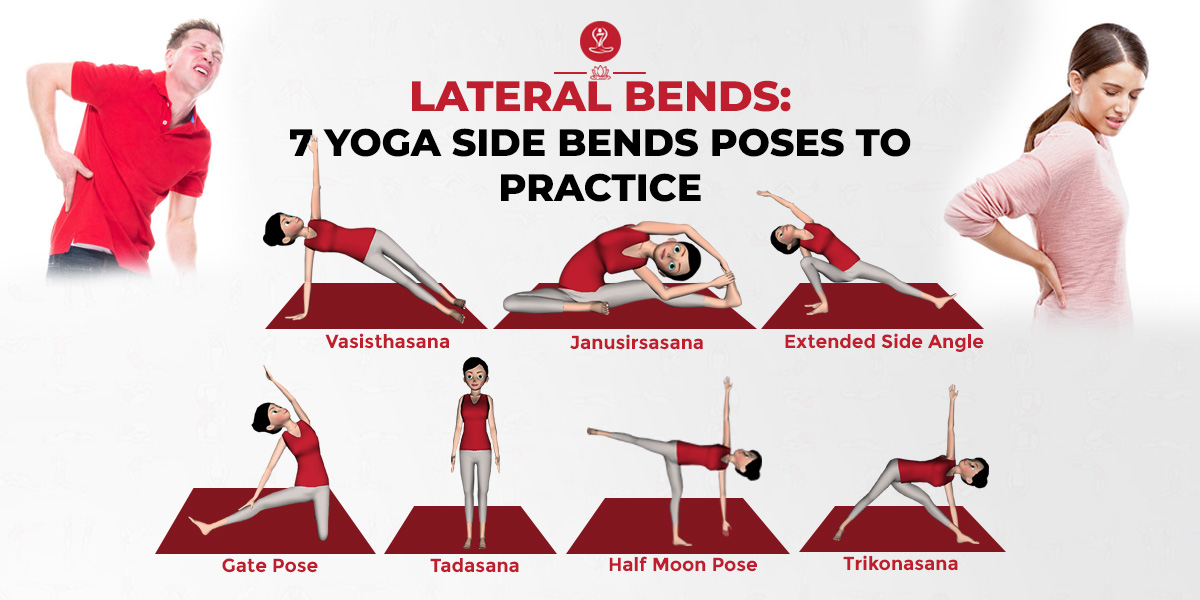
Yoga facet bends, also referred to as lateral bends, are a gaggle of yoga poses that contain bending the backbone sideways, creating a delicate or deep stretch alongside the edges of the physique. These poses sometimes contain elongating one facet of the torso whereas actively contracting and fascinating the muscle tissues on the other facet.
Advantages of Facet Bending in Yoga
Yoga facet bends are practiced for numerous causes, together with bodily, energetic, and psychological advantages.
Listed here are some key advantages and explanation why incorporating facet bends into your yoga apply will be useful:
Facet bends are a wonderful train to launch stress, improve flexibility, improve respiratory capability, construct energy, enhance mobility, and promote a more healthy vary of movement within the backbone. They construct stamina and endurance, enhance focus and result in a sense of lightness, freedom, and emotional launch. Common apply of those yoga postures may even present the next advantages:
- Stretch and strengthen the muscle tissues alongside the edges of the backbone.
- Improved posture.
- Facet bends stimulate and steadiness the power channels (nadis) within the physique.
- Open the intercostal muscle tissues and the muscle tissues surrounding the ribs.
- Strengthen the muscle tissues of your core.
- Opening the facet physique.
- Improves circulation
- Elevated lung capability
- Energetic steadiness.
- Open the heart
Yoga Facet Bends Poses
Yoga facet bends will be carried out in numerous positions, together with standing, seated, or mendacity down. They usually contain reaching the arms overhead or to the facet whereas sustaining a lengthened backbone. Some frequent yoga facet bend poses embrace:
Mountain Facet Stretch Pose ( Triyaka Tadasana)
Inhale and lift your arms overhead, interlocking your fingers and urgent your palms towards the ceiling. Exhale and lean gently to 1 facet, lengthening the other facet of your physique. Maintain for just a few breaths, feeling the stretch alongside the facet physique. Inhale to come back again to the middle and repeat on the opposite facet.
Triangle Pose (Trikonasana)
Step your toes broad aside, about 3 to 4 toes. Flip your proper foot out 90 levels and pivot your left foot barely inward. Prolong your arms out to the edges parallel to the ground. Inhale and attain ahead along with your proper hand, hinging on the hip, after which place your proper hand in your shin, ankle, or a block. Prolong your left arm up in direction of the sky, making a straight line out of your left heel to your fingertips. Maintain the Triangle pose for a number of breaths, feeling the stretch alongside the facet physique. Inhale to come back again up and repeat on the opposite facet.
Half Moon Pose (Ardha Chandrasana)
This standing balancing pose includes balancing on one leg whereas extending the opposite leg straight out to the facet. The hand of the decrease arm rests on the bottom or a block, whereas the higher arm extends in direction of the sky, making a lateral stretch.
Gate Pose (Parighasana)
Come to a kneeling place along with your knees hip-width aside. Prolong your proper leg out to the facet, retaining your foot grounded. Inhale and lift your left arm up overhead. Exhale and lean to the appropriate, bringing your proper hand down in direction of your proper leg, or a block. Really feel the stretch alongside the left facet of your physique. Maintain for just a few breaths after which return to the middle. Change sides and repeat Parighasana.
Prolonged Facet Angle (Utthita Parsvakonasana)
This standing pose includes extending one leg to the facet, bending the entrance knee, and putting the hand of the entrance arm on the bottom or a block. The opposite arm reaches overhead, making a diagonal facet stretch.
Head to Knee Pose (Janusirsasana)
Head-to-Knee Forward Bend is a seated yoga pose that gives a deep stretch to the again of the legs, hips, and backbone. Begin by sitting on the ground along with your legs prolonged straight in entrance of you. Bend your proper knee and produce the only real of your proper foot in opposition to the interior left thigh. Preserve your proper knee grounded on the ground. lengthening your backbone and slowly fold ahead from the hips, reaching towards your left foot with each palms. Prolong your chest in direction of your left leg. Keep within the pose for 30 seconds to a minute, respiratory deeply and sustaining a delicate stretch.
Facet Plank Pose (Vasisthasana)
Vasisthasana is an intermediate to superior yoga pose that strengthens the arms, core, and legs whereas bettering steadiness and stability. Begin by coming right into a plank place. Shift your weight onto your proper hand and roll onto the outer fringe of your proper foot, stacking your left foot on high of the appropriate. Prolong your left arm towards the ceiling, aligning it along with your shoulder. Press via the interior edges of your toes and the outer fringe of your proper hand to raise your hips. Make a straight line out of your head to your heels. Maintain the pose for 30 seconds to a minute.
These are only a few examples of yoga facet bends, and there are lots of variations and modifications obtainable to accommodate totally different ranges of flexibility and physique sorts.
Conclusion
Yoga facet bends poses are a gaggle of yoga asanas that contain bending the backbone sideways, making a stretch alongside the edges of the physique. And will be practiced in numerous positions, together with standing, seated, or mendacity down.
Incorporate facet bends into your each day yoga routine to really feel stretch the muscle tissues in your sides and open the rib cage and increase the chest. They construct stamina and endurance, construct energy, enhance mobility, and improve immunity and power ranges.